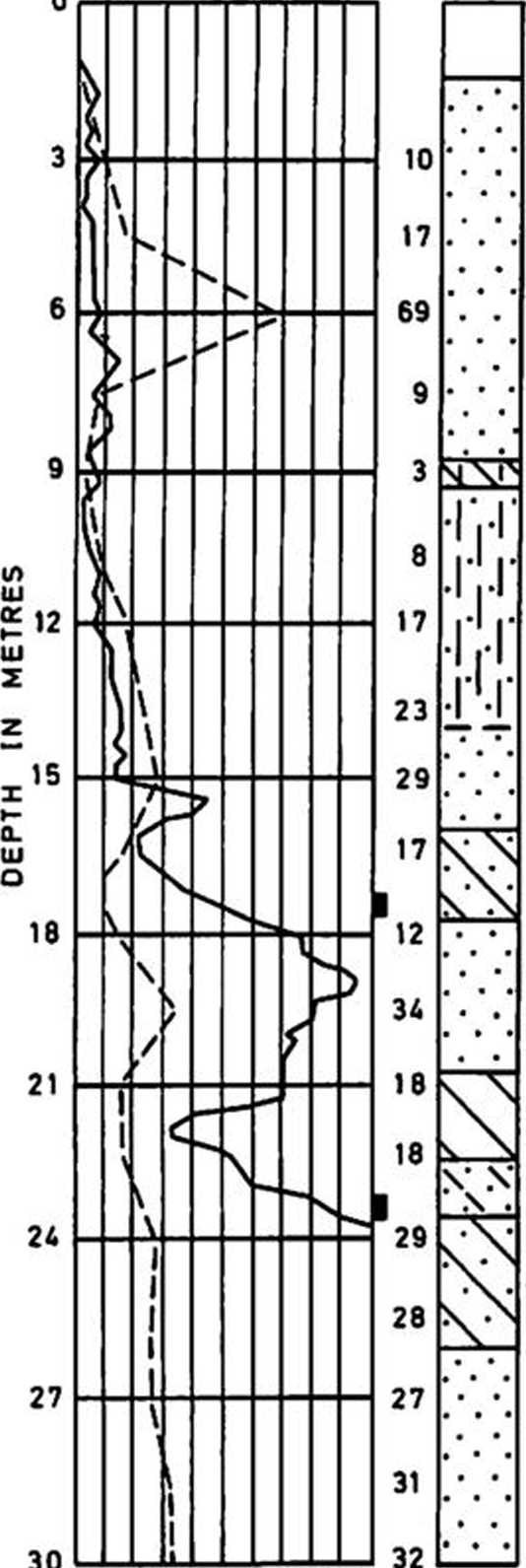6585844993
205
South Africa
BLOWS PER 300mm
o o o o S.P.T.
™ ^ io co N DESCRIPTION

Dark gray loose fine SAND
Dark grey soft silty CLAY
Dark grey loose silty SAND with shells
Brown medium dense gritty SAND
Yellow and grey soft*sandy CLAY
Light yellowish orange dense fine SAND
Light grey stiff CLAY
Light red medium dense clayey SAND
Yellow and brown very stiff sandy CLAY
Light yellow dense fine SAND
| U U Tubę Sampte — S.P.T. N Values
Fig. 3. Results of dynamie cone penetration test in alluvial sediments.
the anvil is thus somewhat less than for a free-falling hanuner. Where access is difficult the test is performed using a tripod. The drive hammer is raised manu-ally by means of a ropę and pulley and is dropped simply by releasing the ropę.
Here again the frictional characteristics of the drive hammer system will be diffe-rent from those employing a free-falling hammer.
Recording of Test Results.
In Figurę 3 the results of a dynamie cone penetration test in estuarine sediments are plotted and compared with the results of standard penetration tests in a 150 mm wash boring approxiraately a metre away. Dynamie cone penetration tests, as in this example, are carried out continuously down the soil profile. They can be performed morę guickly and econoraically than borings with standard penetration tests, and are employed to provide Information on subsoil stratification and variability after cor-relation with the results of boreholes and standard penetration tests at the same site. Depth to which such tests are carried out is generally limited to about 15 to 20 m in loose to moderately dense clayey sands. They can, in fact, pene-trate considerably deeper in the soft estuarine clays of the Coastal areas, but in these situations static penetration tests are morę commonly employed.
Hlley Pile Test
Another form of dynamie cone penetration test sometimes employed to investigate pile founding strata is the Hiley pile test. A light pile driving frame equip-ped with a 453,5 kg (1000 lb.) drop hammer is employed for the test. The pile itself consists of steam tubę of about 115 mm outside diameter fitted with a conical cast iron driving shoe approximately 160 mm diameter. For the first 3 m of penetration the fali of the hammer is 50,8 cm (20 inches) and inereases by 7,6 cm (3 inches) for every 3 m of penetration to allow for inereased driving resistance due to side friction. The blow count, which reflects the stratification of the subsoil, is recorded for each 300 mm of penetration on a diagram similar to Figurę 3.
With the developraent of the Dutch static cone penetration test the Hiley test has been used to a lesser extent during recent years, but in deep estuarine sediments which offer too great a resistance to the Dutch static cone penetrometer the Hiley test has proved to be useful. In such situations it has been employed to pro-vide gualitative Information to depths of up to 70 m. Comparisons of the bearing capacity of the various subsoil strata are sometimes madę, on an approximate basis, by applying the Hiley pile driving formula, in the form given by The British Steel Piping Company (1954), to the test results.
D.C.P.T.
Excavation for obstructions
Portable Cone Penetrometer Tests.
Three forms of light portable dynamie cone penetrometer, which are basically similar, are employed in South Africa.
Smali Dynamie Cone Penetrometer.
This penetrometer comprises a hardened Steel cone 25 mm in diameter with an apex angle of 60 degrees and has been in use, particularly in the Natal Coastal area and parts of the Transvaal and Orange Free State, for many years. The cone is
Wyszukiwarka
Podobne podstrony:
296 Sprawozdania i recenzje H. J. Deacon: Notę on the X-ray of two mounted implements from South Afr
BECKLEY (L.E.) 1984 : The ichthyofauna of the Sundays estuary, South Africa, with particular re
1 Physical Sciences NWO-NRF: Cooperation between the Netherlands and South Africa on Astronomy and E
I ntroductionBackground The Netherlands and South Africa have a joint interest in promoting and stre
I ntroductionBackground The Netherlands and South Africa have a joint interest in promoting and stre
62os 6 Lagos, Nigeria. Capc Town, South Africa. Yictoria, Australia. awkłtonc Parli, Englarv
165. Tnc deicgatiom of Bur ma and South Africa arc noc sarisncd that ihc nghts ani interesu of the b
Penetration testing in South Africa esoptD.L. Webb State-of-the-
204 South Africa PENETRATION RESISTANCE DESCRIPTION Dark brown ioose fine SAND Dark yellowish brown
206 South Africa screwed to the end of a string of solid £lush jointed rods approximately 15 mra
207 South Africa The CBR penetrometer is intended for use where access is difficult for
208 South Africa Fj = Total Shaft Friction q c = Cone Resistance Fig. 5. Results of Dutch static con
209 South Africa E* = 358(N + 5) kN/ra2 (5) in saturated clayey fine sands. Ratios
210 South Africa The dynamie cone penetrometer has, how-ever, been used fairly extensively to es-tlm
211 South Africa Fig. 8. Evaluation of in Dutch static cone penetration test. (10) ult Flats areas,
212 South Africa TABLE 3 Bearing Capacity
więcej podobnych podstron